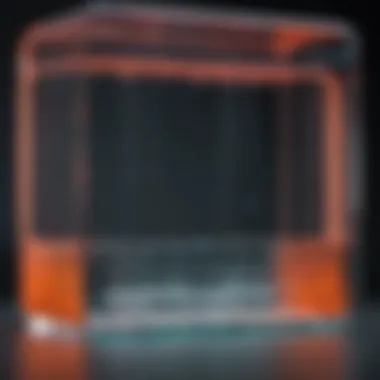Understanding Gel Electrophoresis: Key Concepts & Uses


Intro
Gel electrophoresis is a vital technique in molecular biology and biochemistry. It enables scientists to separate macromolecules, primarily nucleic acids and proteins, based on their size and charge. This unit serves multiple purposes across diverse fields such as genetics, forensics, and biotechnology. The intricate mechanisms and applications of gel electrophoresis merit a thorough examination to appreciate its significance in modern science.
Research Overview
Understanding gel electrophoresis requires a look into its operational mechanics and importance in various scientific domains. This technique is essential for DNA analysis, facilitating genetic fingerprinting and mutation identification. In protein studies, gel electrophoresis helps scientists analyze protein structure and function.
Summary of Key Findings
The key findings of numerous studies emphasize the efficiency of gel electrophoresis in resolving complex mixtures of biological molecules. For example, its use in DNA sequencing has dramatically advanced genetic research and diagnostics. The reliability of this method also extends to protein purification, offering insights into enzyme behavior and cellular processes. The following highlights showcase its versatility:
- DNA Fragmentation Analysis: It provides clear visualization of DNA fragments to confirm successful amplification or digestion.
- Protein Purification: Researchers can isolate proteins for further analysis of their functional properties.
- Forensic Applications: It assists in identifying biological samples, supporting criminal investigations.
Importance of the Research
The ongoing research in gel electrophoresis is crucial for refining methodologies and improving accuracy. As new materials and techniques emerge, the overall efficacy of this technique continues to enhance the precision of molecular analyses. This impacts various applications, such as:
- Medical Diagnostics: Early detection of diseases through precise DNA and protein assessments.
- Biotechnology Advancements: Research on genetically modified organisms and synthetic biology.
Methodology
In the context of gel electrophoresis, exploring the methodology is instrumental in understanding the protocols utilized in scientific research. The standard methodological approach includes several stages, each pivotal to successful outcomes.
Study Design
The design of studies utilizing gel electrophoresis typically encompasses control and experimental groups to ensure that results are valid and repeatable. Whether investigating the effects of a specific treatment on protein expression or analyzing DNA samples, a structured study design is essential.
Data Collection Techniques
Data collection in gel electrophoresis involves:
- Sample Preparation: Properly obtaining and preparing samples to ensure quality results.
- Electrophoresis Setup: Utilizing appropriate gel matrices, buffers, and voltage settings to achieve effective separation.
- Visualization and Analysis: Employing staining techniques and imaging systems to visualize separated molecules for further examination.
"Gel electrophoresis remains an indispensable tool, providing crucial data for biological research and application."
The relevance of gel electrophoresis in scientific inquiry cannot be understated. Its capacity to effectively separate and analyze biological macromolecules has made it a cornerstone technique for researchers across disciplines.
Foreword to Gel Electrophoresis
Gel electrophoresis plays a pivotal role in molecular biology, biochemistry, and genetics. Its significance lies in the ability to separate and analyze large molecules such as DNA, RNA, and proteins based on their size and charge. This technique allows researchers to conduct experiments that illuminate intricate biological processes. By employing gel electrophoresis, scientists can quantify genetic material, study protein interactions, and explore cellular functions more thoroughly.
The introduction of this technique has facilitated groundbreaking discoveries and propelled advancements in various scientific fields. Hence, understanding gel electrophoresis is not only beneficial but essential for students, educators, researchers, and professionals engaged in life sciences.
Definition and Importance
Gel electrophoresis is defined as a technique that uses an electric field to separate charged particles within a gel medium. The gel acts as a molecular sieve, allowing smaller molecules to migrate faster than larger ones. When an electrical current is applied, the molecules move towards the electrode with the opposite charge. This property is crucial for laboratory settings when analyzing the composition of biological samples.
The importance of gel electrophoresis extends far beyond just separation. It provides insights into the molecular weight of various substances, enabling further experimentation. In molecular biology, this technique is integral in applications such as DNA fingerprinting, cloning, and sequencing. Additionally, it supports clinical diagnostics, where analyzing proteins or nucleic acids can reveal abnormalities associated with diseases. Therefore, mastering gel electrophoresis is vital for those involved in scientific research.
Historical Perspective
The history of gel electrophoresis dates back to the mid-20th century when researchers began exploring methods to separate biological macromolecules for analytical purposes. Initially, starch gels were utilized, which, despite their utility, had limitations. The introduction of agarose gels in the 1970s marked a significant advancement, enabling better resolution and separation capabilities.
The development of polyacrylamide gels provided even greater resolution than agarose. It facilitated the separation of smaller molecules, thus expanding the applications of gel electrophoresis. This evolution fostered innovations in genetic research, proteomics, and forensic science.
Over time, gel electrophoresis has evolved into a standard procedure in laboratories worldwide. Its integration with other techniques, such as PCR and western blotting, demonstrates its versatility and importance in modern scientific inquiry. Understanding the historical context enables a deeper appreciation for its mechanics and applications in contemporary research.


Fundamental Principles
Understanding the fundamental principles of gel electrophoresis is crucial for anyone engaging with the technique. These principles not just dictate how electrophoresis operates but also outline its effectiveness in various applications. Electrophoresis relies fundamentally on the movement of charged particles in a gel matrix when an electric current is applied. This principle allows for the separation of biological molecules based on size and charge, illuminating the way for various scientific advancements.
Through grasping these concepts, one can appreciate how gel electrophoresis contributes to molecular biology. The precision in molecule separation is enhanced by the fundamental principles behind the technique. Whether it's DNA analysis or protein separation, the principles guiding this method remain consistent.
Basic Concepts of Electrophoresis
The basic concepts of electrophoresis involve the interaction of electric fields with charged particles. When an electric field is applied, charged molecules migrate towards the electrode of opposite charge. This migration occurs through a gel medium, which acts as a sieve, separating molecules based on their size and charge. The process provides a visual representation of the molecular composition and is indispensable in laboratories worldwide.
Factors Affecting Separation
Several factors influence the efficiency of separation during gel electrophoresis. These include the charge of the molecules, their size and shape, and the composition of the medium used.
Charge of Molecules
The charge of molecules plays a pivotal role in gel electrophoresis. Charged molecules move towards the electrode of opposite charge when subjected to an electric field. Molecules with a higher charge density migrate faster than those with lower charges. This characteristic makes it essential to consider the ionic state of the molecules during experimentation. It is a beneficial choice for achieving accurate and reproducible results across a broad range of applications. However, charge variability in proteins, for instance, may lead to complexities in interpretation.
Size and Shape
The size and shape of molecules significantly contribute to separation efficiency. Larger molecules typically migrate slower compared to smaller ones. This inherent difference allows researchers to delineate sizes within a sample. Different shapes can also affect how molecules navigate through the gel matrix. For example, a long, thin molecule might navigate differently compared to a spherical one. Thus, it is crucial to keep in mind that size and shape can influence the overall resolution of the separation results.
Medium Composition
The composition of the medium impacts not only the pore size of the gel but also the ionic strength of the buffer solutions used. Commonly, agarose and polyacrylamide gels are used, each offering distinct advantages. Agarose gels are generally preferred for nucleic acids due to their larger pores, while polyacrylamide gels provide better resolution for smaller proteins. The selection of gel type directly affects the outcomes of the electrophoresis process, making a thorough understanding of medium composition a necessity in experimental design.
Components of a Gel Electrophoresis Unit
Understanding the components of a gel electrophoresis unit is crucial for anyone involved in molecular biology or biochemistry. Each element plays a distinct role in the process of separating nucleic acids or proteins, making it imperative for users to familiarize themselves with these components and their functions. The effectiveness and reliability of gel electrophoresis largely depend on the correct specification and calibration of these components. Here's a deeper look into each essential component:
Power Supply
The power supply is a critical component in the gel electrophoresis unit. It is responsible for generating the electric field required for the movement of charged molecules through the gel matrix. The current delivered by the power supply influences the separation resolution and speed of the electrophoresis process.
When selecting a power supply, users must consider factors such as voltage output and consistency. A well-regulated power supply helps to prevent overheating of the gel and potential damage to samples. For most applications, a power supply that can support multiple voltage and current settings is preferred, as it allows for adaptability in running various types of gels.
Gel Tray and Focusing Mechanism
The gel tray is the foundation of the electrophoresis process. It holds the gel in place while samples are loaded and during the separation. The design of the gel tray can impact how efficiently the gel maintains its integrity during running. Additionally, some gel trays come with in-built focusing mechanisms that help concentrate the samples to improve resolution.
Understanding the specifics of a gel tray's configuration can aid in ensuring uniform sample distribution and reducing other technical problems during the separation process.
Buffer Solutions
Buffer solutions play a vital role in gel electrophoresis by maintaining a stable pH and providing the necessary ionic strength for electrophoretic migration. These solutions facilitate the movement of charged particles while preventing pH fluctuations that could affect sample integrity.
It is important to choose the correct buffer for your specific application, as different buffers can yield different results. Common buffers include Tris-acetate-EDTA (TAE) and Tris-borate-EDTA (TBE), each with its unique properties that can affect the resolution and stability of the samples.
Agarose vs. Polyacrylamide Gels
The choice between agarose and polyacrylamide gels significantly impacts the outcome of electrophoresis. Agarose gels are generally employed for the separation of larger DNA fragments, while polyacrylamide gels are used for smaller fragments and proteins.
Agarose gels are easier to prepare and handle, making them suitable for routine applications. In contrast, polyacrylamide gels offer higher resolution and can be tailored for specific sample types. Evaluating the properties and benefits of each gel type can foster better decisions based on the specific research requirements.
"The choice of gel type can alter the entire experiment’s outcome. Therefore, it is critical to select the gel best suited for your specific separation needs."
Understanding these components is fundamental for students and professionals, as they will influence the quality and accuracy of experimental results. By comprehensively grasping these details, users can optimize the gel electrophoresis process for various scientific applications.


Procedural Methodology
The procedural methodology in gel electrophoresis is a crucial aspect that defines how effective the separation of biomolecules can be. Each step in this process requires careful execution and understanding to ensure the accuracy and reliability of the results. By focusing on the specifics, researchers can optimize their experiments to enhance the overall performance of gel electrophoresis. This section will delve into the steps involved in this method, emphasizing the significance of each part of the procedure.
Preparation of Gel
The preparation of the gel is the first step in the electrophoresis process. There are two common types of gels used in molecular biology: agarose and polyacrylamide. The selection of the gel type depends on the size of the molecules being analyzed. Agarose gels are usually suitable for larger DNA fragments, while polyacrylamide gels are preferred for smaller proteins and DNA samples.
To prepare the gel, the following steps should typically be followed:
- Select the appropriate gel concentration. This will depend on the size of the molecules.
- Mix the gel powder with a buffer solution, heating it until fully dissolved.
- Allow the solution to cool before pouring it into the gel tray to solidify.
- Insert a comb into the gel to create wells for sample loading.
- Let the gel solidify completely.
Precision in preparation affects the quality of the separation, as uneven gels can lead to distorted bands during electrophoresis.
Sample Loading Techniques
Loading samples correctly into the gel is another important step. Poor loading techniques can result in inaccurate data and can compromise the whole experiment. Here are some recommended loading techniques:
- Use a micropipette for accuracy. This ensures that the correct volume is loaded into each well.
- Align the tip of the pipette with the well to avoid spillage. This ensures that the sample goes directly into the intended space.
- Avoid introducing bubbles. Bubbles can disrupt the flow of the gel and lead to erroneous results.
- Label wells clearly. This prevents confusion during analysis.
Using these techniques will promote consistent results and improve the fidelity of the experiments.
Running the Gel
Once the samples are loaded, the next step is to run the gel. This involves applying an electric current via the power supply to the gel, which causes the charged molecules to migrate. The distance traveled by the molecules depends on their size and charge. Key considerations while running the gel include:
- Select the appropriate voltage. High voltages can run the gel faster but may lead to heat generation, causing distortion.
- Control the running time. Timing is critical, as stopping too early or running too long can lead to inconclusive results.
It is also essential to monitor the progress throughout the run.
Staining and Visualization
The final step is staining and visualization, which allows for the identification of the separated bands. Common stains include ethidium bromide and SYBR Green, both of which intercalate with DNA. Here’s how it typically works:
- Submerge the gel in the staining solution. This step may take varying durations depending on the stain used.
- Rinse the gel to remove excess stain.
- Visualize the gel under UV light or other imaging systems. This facilitates the identification of bands based on their size and intensity.
Visualizing the results correctly is vital. A clear outcome indicates a well-conducted experiment and allows for accurate analysis of the data collected.
Proper procedural methodology significantly influences the outcomes of gel electrophoresis, making it essential for high-quality research and reliable results.
These steps encompass the procedural methodology in gel electrophoresis. By mastering each of these stages, researchers can achieve superior outcomes in their molecular analyses.
Applications of Gel Electrophoresis
The applications of gel electrophoresis are extensive and varied, serving as a fundamental technique in many branches of biological and chemical research. The importance of this topic lies in its versatility, enabling researchers to analyze complex biomolecules with precision. The benefits of gel electrophoresis include its ability to facilitate the separation of nucleic acids and proteins, making it integral in disciplines such as molecular biology, genetics, and forensic science.
DNA Analysis
In DNA analysis, gel electrophoresis plays a pivotal role. It allows researchers to visualize and separate DNA fragments that are produced during processes such as restriction enzyme digestion or PCR amplification. By applying an electric current through an agarose gel, DNA molecules move based on their size. Smaller fragments migrate faster, resulting in bands that can be interpreted for various applications such as gene cloning, sequencing, or mutation detection. This technique is essential in genetic mapping and identifying genetic disorders. It also has practical applications in biotechnological innovations, such as CRISPR technology.
Protein Separation
Protein separation is another significant application of gel electrophoresis. This technique is fundamental when it comes to resolving complex protein mixtures. The separation is typically performed using polyacrylamide gels, which provide better resolution for proteins compared to agarose gels. The movement of proteins under an electric field depends not only on their size but also on their charge at a given pH. After running the gel, proteins can be visualized using specific stains like Coomassie Blue or silver staining. This method is vital in proteomics for identifying post-translational modifications and understanding protein interactions, which are critical for advancing knowledge in cell biology and disease mechanisms.
Forensic Science
Forensic science heavily relies on gel electrophoresis for DNA profiling and other analyses. In criminal investigations, this technique is employed to analyze DNA samples collected from crime scenes, enabling forensic experts to match samples with suspects. The precision and reliability of gel electrophoresis enhance the integrity of forensic evidence. Additionally, it is used in paternity testing and identifying individuals through genetic markers. As such, advancements in gel electrophoresis techniques directly contribute to enhancing forensic methodologies and improving the justice system's effectiveness.


Genetic Engineering
In the field of genetic engineering, gel electrophoresis is crucial for the development and implementation of gene therapies and genetically modified organisms (GMOs). Researchers utilize this technique to confirm the success of transformations and to analyze the expression of recombinant genes. By examining the purity of plasmid preparations or assessing the insert sizes in vectors, gel electrophoresis aids in ensuring that engineered genes function as intended. The potential for innovative applications in this area is vast, influencing agriculture, medicine, and environmental strategies.
"Gel electrophoresis is not just a laboratory technique; it is a gateway to technological advancement in genetics and molecular biology."
Challenges and Limitations
The field of gel electrophoresis, while being a vital analytical tool in molecular biology, does not come without its set of challenges and limitations. Understanding these issues is essential for effectively employing this technique in research and diagnostics. It helps researchers to be aware of potential pitfalls, ensuring that they interpret their findings accurately. In this article, we will examine two key areas: resolution issues and interpretation of results.
Resolution Issues
One major challenge with gel electrophoresis is obtaining high resolution for the separation of biomolecules. Resolution refers to the ability to see distinct bands or spots on a gel. Factors that affect resolution include the type of gel used, the pore size, and the operating conditions.
- Type of Gel: Both agarose and polyacrylamide gels have distinct properties. Agarose gels are typically used for larger DNA fragments, while polyacrylamide gels allow better resolution for smaller fragments due to their tighter pore structure. Choosing the right gel is crucial for achieving the desired resolution.
- Pore Size: The size of the pores in the gel can greatly influence separation. When the pores are too large, the bands may diffuse, making them less distinct. Conversely, if the pores are too small, larger molecules may not migrate efficiently.
- Voltage and Time: Higher voltage can lead to faster results, but it may also cause overheating or distort bands. Finding an appropriate balance between time and voltage is necessary for optimal separation.
Improving resolution often comes at a cost to other parameters such as speed or sample load. Thus, researchers must carefully consider their specific needs when planning experiments.
Interpretation of Results
Accurate interpretation of results from gel electrophoresis also poses challenges. Band patterns can sometimes be ambiguous, leading to misinterpretations. Several factors can contribute to this issue:
- Band Smearing: This occurs when bands are not sharp and clear. Smearing often results from degraded samples or improper loading techniques. It obscures the true picture of the sample's content.
- Non-Specific Binding: Certain staining agents may bind to multiple types of molecules, creating bands that do not reflect the actual composition of the analyzed sample. This can lead to false conclusions about the presence or absence of specific proteins or nucleic acids.
- Quantitative Analysis: While gel electrophoresis can provide qualitative data, obtaining quantitative results can be problematic. Differences in band intensity can be influenced by several variables, including sample loading volume and gel thickness. Researchers need to be cautious in extrapolating concentration from band intensity without proper controls.
"Understanding and addressing the challenges of gel electrophoresis ensures that the results derived are reliable and meaningful as a component of scientific inquiry."
Navigating these challenges is critical for enhancing the efficiency and accuracy of gel electrophoresis applications. Acknowledging these limitations and being aware of ways to mitigate them can significantly improve both research outcomes and diagnostic accuracy.
Future Directions in Gel Electrophoresis
The field of gel electrophoresis is evolving. Continuous advancements are pivotal for enhancing efficiency and accuracy in scientific research. Understanding these future directions is crucial for researchers and professionals who rely on this technique. New technologies may overcome current limitations and drive innovative applications across different disciplines.
Advancements in Gel Technology
Recent developments in gel technology show great promise. Researchers are investigating materials with improved properties for gel formation. For instance, synthetic gels offer better control over pore size. This translates to enhanced resolution during separation processes. The introduction of nanotechnology in gel manufacturing is also notable. Nanoparticle-infused gels can demonstrate elevated conductivity and stability, leading to faster results.
Moreover, the integration of automation in gel preparation is on the rise. Automated systems can standardize gel preparation, reducing human error and variability. This kind of efficiency is essential in high-throughput scenarios, which are increasingly common in laboratories. Additionally, new staining techniques are being developed. These provide improved sensitivity and reduce background noise during visualization.
Integration with Other Techniques
Combining gel electrophoresis with other analytical techniques is an area of significant interest. For example, coupling gel electrophoresis with mass spectrometry enhances analytical capabilities. This integration allows for precise mass determination after electrophoretic separation. It provides a deeper understanding of molecular composition.
Furthermore, the combination of gel electrophoresis with fluorescence techniques allows for real-time monitoring. This can significantly enhance the analytical power and facilitate more detailed studies of biomolecules. Researchers are also exploring the incorporation of gel electrophoresis in microfluidic devices. This brings miniaturization to the forefront, allowing for portable and rapid analyses.
Culmination
The conclusion of this article consolidates fundamental insights into the gel electrophoresis unit. It serves as a vital reference point for students, researchers, and professionals who explore the nuances of molecular biology and biochemistry. Understanding the principles of gel electrophoresis is not just academic; it translates into practical applications that have a profound impact in various fields.
Summary of Key Points
In reviewing the key points from this article, it is essential to highlight several elements:
- Importance of Gel Electrophoresis: This technique is crucial for analyzing nucleic acids and proteins. Its effectiveness in separating biomolecules allows researchers to draw important conclusions from their experiments.
- Structure of the Electrophoresis Unit: Knowledge of the components, including power supply, gel tray, and buffer solutions, is necessary for both practical use and optimization of experiments.
- Procedural Methodology: A clear understanding of preparation, sample loading, and running the gel is necessary for successful outcomes in experiments. This includes various staining and visualization techniques that enhance the results.
- Wide-Ranging Applications: The use of gel electrophoresis extends to DNA analysis, forensic science, and genetic engineering, showcasing its versatility and relevance in diverse scientific fields.
Implications for Scientific Research
The implications of gel electrophoresis in scientific research are significant. They include:
- Enhanced Analytical Techniques: This method allows researchers to achieve higher precision in the analysis of macromolecules, which can lead to breakthroughs in genetic research and biotechnology.
- Innovation and Development: As techniques advance, integration with other methodologies, such as CRISPR and next-generation sequencing, enhances the analytical capabilities offered by gel electrophoresis.
- Standardization of Results: The reproducibility of results obtained through gel electrophoresis creates a reliable framework for validation in experimental data, making it a cornerstone in laboratory protocols.
"Gel electrophoresis not only aids in understanding molecular structures but also drives innovation in scientific research and technique development."
In essence, the conclusion reiterates the relevance of gel electrophoresis as a research tool, emphasizing its role in addressing complex scientific problems, highlighting ongoing innovations, and encouraging further exploration into its applications. By grasping the fundamentals and implications discussed, readers can appreciate the transformative power of gel electrophoresis in the scientific landscape.



